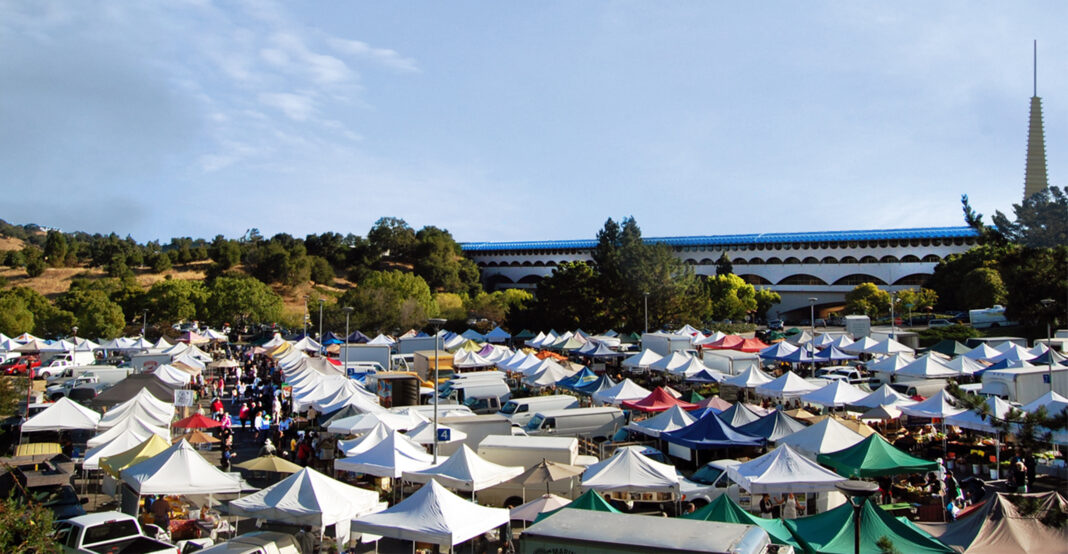Going to the farmers’ market is a weekend activity that many Californians have learned to take for granted. In fact, the market is very much a part of the Golden State stereotypical dream, complete with permanently good weather and friendly folks. But what does it take to run one? Andy Naja-Riese, the newly appointed CEO of the Agricultural Institute of Marin (AIM), knows a thing or two about it; when he begins his position this month, he’ll be running not one, but seven farmers’ markets across the Bay Area, plus a myriad of other tasks geared to promote locally grown food and healthy nutrition.
The Marin Agricultural Institute (MAI) was founded in 2004 by Marin Farmers Markets (MFM), and in 2009, MFM members voted to merge the two organizations into the Agricultural Institute of Marin, with a goal of serving family farmers, specialty food purveyors, artisans and communities. AIM is responsible for seven large farmers’ markets currently operating in the Bay Area: The Thursday and Sunday San Rafael markets, the Hayward and Newark Farmers’ Markets, the Grand Lake market in Oakland and two San Francisco markets, on Clement Street in San Francisco and at the Stonestown Galleria shopping mall. Naja-Riese, who previously served as chief of the Program Integrity Branch of the USDA’s Food and Nutrition Service, Western Region, is ready for the task, which, despite its relative localization, is still rather challenging.
“I’m coming from working with nine states to working with three counties,” he says of the difference. “I’m really excited about supporting work in my backyard, and supporting local communities.”
Going smaller in his national scope doesn’t diminish his excitement. “California is so abundant, you always know you buy foods that were recently harvested, and didn’t have to travel,” Naja-Riese says. “In other states, farmers’ markets may be limited to summer, but here we have four seasons, and you really get to see the incredible variety.”
Naja-Riese lives in San Rafael, having moved to Marin seven years ago from Long Island. Experienced with leading regional work to aid access to nutrition programs, he plans to bring his expertise to his new position, which officially starts on May 7.
When broken down into numbers, the markets sound like a lot—400 vendors, 200 of whom are farmers, 120 food purveyors and 80 artisans, living all over Marin, the Central Valley, Alameda County and beyond. Visitor-wise, the markets draw around 18,000 shoppers per week, or around 1 million annually.
“It’s a nice variety,” Naja-Riese says. “The wonderful thing is that the whole grid supports people from the community and the broader area, and that it’s all supporting local businesses.”
What are the main agendas that Naja-Riese foresees with such a wide network of customers and vendors? “The most important opportunity is that we innovate and create a really meaningful shopping experience,” he outlines. “Sure, people are coming in to buy food from farmers, but there have been changes—you can buy food through your smartphone these days, so we need to be focusing on experiences, and to make sure that they’re innovative and meeting the needs of shoppers and farmers.”
One such activity, which Naja-Riese is planning to capitalize on, is farmers’ market tours, which will educate shoppers about seasonality, recipes and local agriculture. Cooking demos are also in the mix, as are experiences for kids, like scavenger hunts and educational programs. Involving people from the community as ambassadors, greeters and guides is also a budding idea. The new CEO favors technological advancements, too.
“There are exciting ways to incorporate technology,” Naja-Riese says. “After all, we’re moving towards a cashless society. Another element I’m interested in is real-time access to what will be available at the market, or an app that will tell you what recipes you can prepare with the produce you just bought.”
Speaking of trending shopping attractions, there’s yet another thing he’s looking forward to: In 2014, voters of Marin passed a regulation to allow a permanent farmers’ market with a canopy and a market hall, in San Rafael.
“We’ll be working with stakeholders to make sure we define what it may mean,” Naja-Riese shares. “We’re in the process right now of working out the most important elements—what can a canopy mean? An educational program onsite? An onsite garden? In the next few months, we will talk about guidelines.”
Solid plans and implementation of the exciting project, Naja-Riese says, will take place in the next few years.
While apps and plans for swanky markets are exciting to discuss, there are always challenges, like making farmers’ markets more inclusive and affordable, and engaging with a diverse community of shoppers and farmers. The key element, Naja-Riese says, is really getting to know the communities that the markets operate in and making sure that they answer the local needs. Per accessibility, he says, all of the markets accept Supplemental Nutrition Assistance Program (SNAP) coupons and offer programs called ‘market match,’ enabling shoppers to get additional matching dollars for purchases; they also work with the Women, Infants, and Children (WIC) program.
“I will be making sure to meet with the school districts, nonprofits and community organizations to understand the needs,” Naja-Riese says, “and also to make sure, particularly in Oakland and Hayward and Newark, to have vendors that come from the local community. It’s extremely important to support the livelihood of farmers; according to a UC Davis study, every dollar spent at a farmers’ market leads to twice as much economic activity in the local region.”
To connect with more farmers, AIM does outreach with agricultural groups and benefits from the farmers’ own networks and connections. Storytelling and promoting farmers’ markets is another challenge in the digital age, which AIM meets with resources and tools gathered through research.
“I get excited about a lot of the stories we learn from Cooperative Extension, especially the ones about children trying broccoli for the first time or asking their parents to pick unfamiliar foods,” Naja-Riese says.
When he wants to get inspired even further, Naja-Riese visits farmers’ markets around the country; his favorite is located on the Big Island in Hawaii, where, he says, there’s an incredible variety of vendors, and the native local food options are endless. “It was so eye-opening to see and be introduced to new things, have new experiences and meet new people there,” he says.
As one may expect, Naja-Riese is full of useful tips when it comes to making the most of your average farmers’ market visit.
“Shop the seasons, come prepared with a potential list, plan to walk around for an hour to give yourself enough time to experience all of the vendors, bring your own reusable bag and really ask all the questions—farmers are so knowledgeable, so don’t be afraid to reach out,” he says. “And bring family and friends, have a social experience and have fun.”
What about those awkward moments, when you can’t pass up a free sample but end up not buying the product? Just relax, Naja-Riese advises. “It’s good to try new foods! Maybe you won’t buy it today, but you may come back the next week and buy it then.”
Agricultural Institute of Marin; agriculturalinstitute.org.











